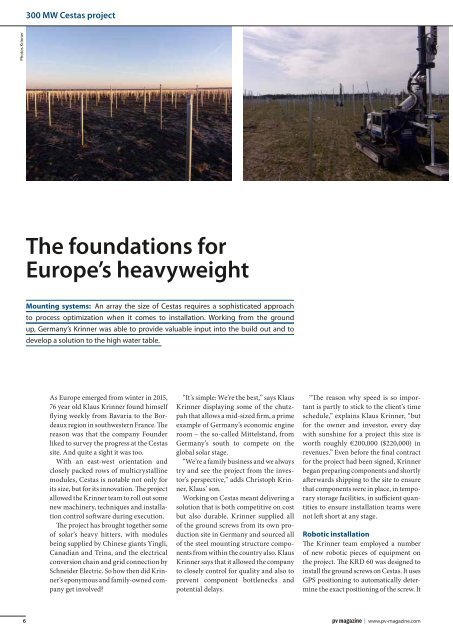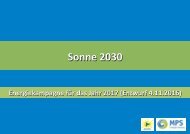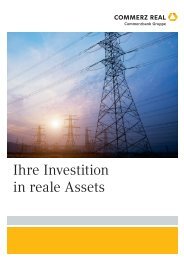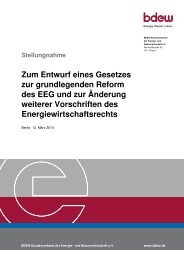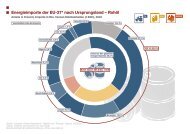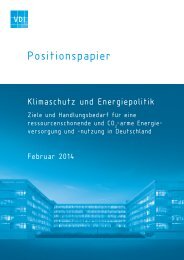Inside Cestas
1Zl7QBV
1Zl7QBV
You also want an ePaper? Increase the reach of your titles
YUMPU automatically turns print PDFs into web optimized ePapers that Google loves.
300 MW <strong>Cestas</strong> project 300 MW <strong>Cestas</strong> project<br />
Photos Krinner<br />
The foundations for<br />
Europe’s heavyweight<br />
Mounting systems: An array the size of <strong>Cestas</strong> requires a sophisticated approach<br />
to process optimization when it comes to installation. Working from the ground<br />
up, Germany’s Krinner was able to provide valuable input into the build out and to<br />
develop a solution to the high water table.<br />
As Europe emerged from winter in 2015,<br />
76 year old Klaus Krinner found himself<br />
flying weekly from Bavaria to the Bordeaux<br />
region in southwestern France. The<br />
reason was that the company Founder<br />
liked to survey the progress at the <strong>Cestas</strong><br />
site. And quite a sight it was too.<br />
With an east-west orientation and<br />
closely packed rows of multicrystalline<br />
modules, <strong>Cestas</strong> is notable not only for<br />
its size, but for its innovation. The project<br />
allowed the Krinner team to roll out some<br />
new machinery, techniques and installation<br />
control software during execution.<br />
The project has brought together some<br />
of solar’s heavy hitters, with modules<br />
being supplied by Chinese giants Yingli,<br />
Canadian and Trina, and the electrical<br />
conversion chain and grid connection by<br />
Schneider Electric. So how then did Krinner’s<br />
eponymous and family-owned company<br />
get involved?<br />
“It’s simple: We’re the best,” says Klaus<br />
Krinner displaying some of the chutzpah<br />
that allows a mid-sized firm, a prime<br />
example of Germany’s economic engine<br />
room – the so-called Mittelstand, from<br />
Germany’s south to compete on the<br />
global solar stage.<br />
“We’re a family business and we always<br />
try and see the project from the investor’s<br />
perspective,” adds Christoph Krinner,<br />
Klaus’ son.<br />
Working on <strong>Cestas</strong> meant delivering a<br />
solution that is both competitive on cost<br />
but also durable. Krinner supplied all<br />
of the ground screws from its own production<br />
site in Germany and sourced all<br />
of the steel mounting structure components<br />
from within the country also. Klaus<br />
Krinner says that it allowed the company<br />
to closely control for quality and also to<br />
prevent component bottlenecks and<br />
potential delays.<br />
“The reason why speed is so important<br />
is partly to stick to the client’s time<br />
schedule,” explains Klaus Krinner, “but<br />
for the owner and investor, every day<br />
with sunshine for a project this size is<br />
worth roughly €200,000 ($220,000) in<br />
revenues.” Even before the final contract<br />
for the project had been signed, Krinner<br />
began preparing components and shortly<br />
afterwards shipping to the site to ensure<br />
that components were in place, in temporary<br />
storage facilities, in sufficient quantities<br />
to ensure installation teams were<br />
not left short at any stage.<br />
Robotic installation<br />
The Krinner team employed a number<br />
of new robotic pieces of equipment on<br />
the project. The KRD 60 was designed to<br />
install the ground screws on <strong>Cestas</strong>. It uses<br />
GPS positioning to automatically determine<br />
the exact positioning of the screw. It<br />
also determines the density of the earth to<br />
ascertain whether ground hammering is<br />
required. It automatically logs its activity<br />
so it can be monitored off-site, in fact back<br />
in Bavaria, by the Krinner team.<br />
The marking of the ground was also<br />
carried out by a new machine. Krinner<br />
employed a surveying robot to precisely<br />
locate the layout of the ground screw<br />
placement and to pre-drill where necessary.<br />
“As far as we know, it is the only<br />
machine worldwide that is capable of<br />
doing that,” says Klaus Krinner.<br />
As the installation took place partly<br />
over winter, something that is often<br />
avoided in colder parts of Europe, the<br />
installation teams had to potentially deal<br />
with large amounts of rain. A new tool<br />
featuring thin wheels to cut into the top<br />
soil to allow it to drain, however not to<br />
form deep trenches, was employed. The<br />
machines also had to ensure that they<br />
did not place too much pressure on sodden<br />
earth while at the same time keeping<br />
components off the ground. Special trailers<br />
were designed to transport the modules<br />
through the tightly packed rows.<br />
The high energy density of the array<br />
was one of the inputs that Krinner had<br />
into the project. The team realized a<br />
design in which one hectare of land can<br />
be equipped with 1.15 MW of modules.<br />
Special installation equipment had to<br />
be designed to operate in the confined<br />
spaces. The east-west module configuration<br />
does lend itself to the high density,<br />
but it was chosen for its more stable production<br />
profile, including its production<br />
in the morning and evening.<br />
In terms of cost, the Krinner team<br />
reports that it was able to be competitive<br />
with Asian suppliers, even with components<br />
being produced in Europe. While<br />
Krinner was not the cheapest provider,<br />
the family team learned after being<br />
awarded the project, it was the additional<br />
inputs that Krinner’s engineers<br />
and machinery providers themselves<br />
delivered that set them apart.<br />
“We don’t only see the cost of the material<br />
up until the completion of construction,<br />
but we also see the 20 to 25 year lifetime<br />
of the array,” says Michael Krinner,<br />
Klaus’ nephew. “So taking that all into<br />
account, it is cheaper to produce in Germany.”<br />
Klaus Krinner says he has seen<br />
arrays in Germany where module degradation<br />
has been as little as 0.02% annually.<br />
“The limiting factor to a project’s life<br />
is usually the module, so we want the<br />
mounting systems to exist for far longer<br />
than the panel,” says Klaus Krinner. “In<br />
case it should stay there for 100 years, it<br />
can be done.” It is hard to imagine such<br />
a vast project as <strong>Cestas</strong> being in place for<br />
quite such a long time, but time will tell.<br />
6<br />
| www.pv-magazine.com | www.pv-magazine.com<br />
7


